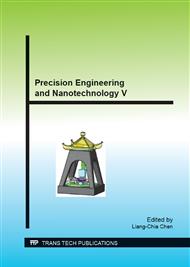p.483
p.489
p.496
p.505
p.511
p.518
p.525
p.530
p.536
Electro Discharge Machining of AL2O3 Based Ceramic
Abstract:
Products such as parts of die sets and cutting tool inserts are normally produced with complex shapes in materials of high hardness and wear resistance such as ceramics. Electro discharge machining (EDM) can be used to manufacture complex shapes in high hardness materials, but the material should be conductive. Being conductive, Aluminum oxide (Al2O3) based ceramics represent a good alternative for manufacturing hard complex shape parts. However, the integrity of the produced surfaces and the material removal rate need to be investigated. A full factorial experimental design was used to investigate the effect of some selected process variables, namely; pulse-on time, pulse-off time, and pulse current on specific EDM performance measures. The considered performance measures are; crater diameter (D), material removal rate (MRR), and average roughness value (Ra). An analysis of variance (ANOVA) test was carried out to evaluate the experimental results. Empirical models have been developed using DESIGN EXPERT V.8 to predict the average crater diameter (D), material removal rate (MMR), and average roughness value (Ra). Machining conditions that should result in optimum process performance measures have also been considered.
Info:
Periodical:
Pages:
511-517
Citation:
Online since:
August 2014
Authors:
Keywords:
Price:
Сopyright:
© 2015 Trans Tech Publications Ltd. All Rights Reserved
Share:
Citation:


